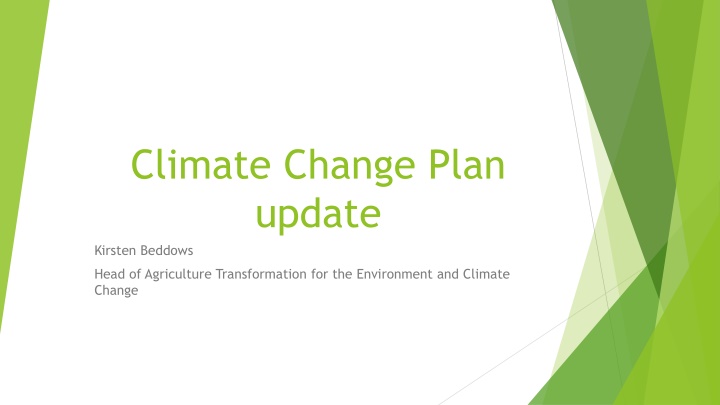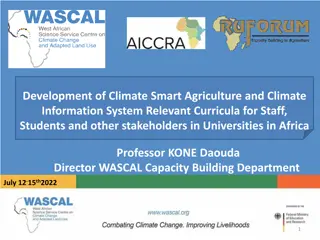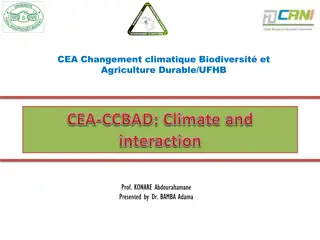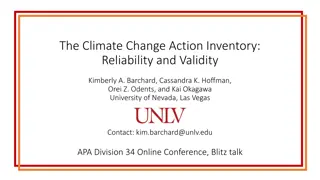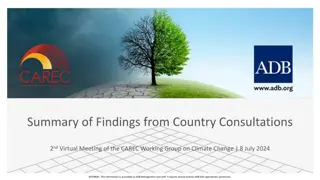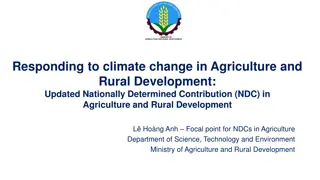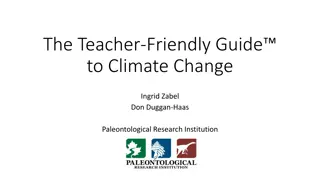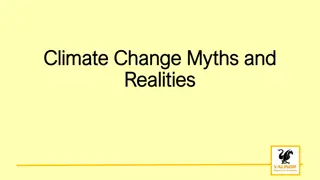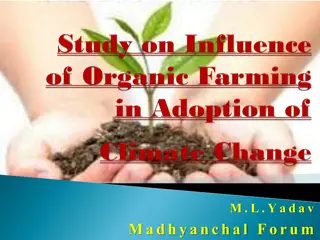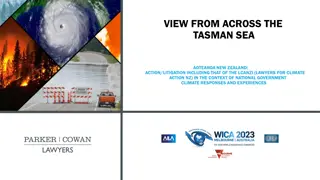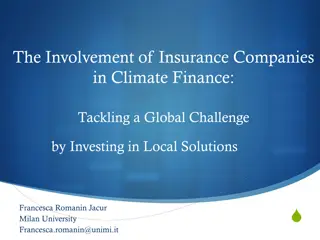Transforming Agriculture for Climate Change: Kirsten Beddows' Vision
Kirsten Beddows, Head of Agriculture Transformation, shares an updated Climate Change Plan focused on reducing emissions, achieving net-zero by 2045, and creating sustainable farming practices. The plan includes over a hundred new policies targeting emissions reduction, land use optimization, and carbon sequestration. Key outcomes involve increasing climate awareness among primary food producers, reducing nitrogen emissions, improving emissions intensity of red meat and dairy, and enhancing carbon sequestration on agricultural land.
Download Presentation

Please find below an Image/Link to download the presentation.
The content on the website is provided AS IS for your information and personal use only. It may not be sold, licensed, or shared on other websites without obtaining consent from the author.If you encounter any issues during the download, it is possible that the publisher has removed the file from their server.
You are allowed to download the files provided on this website for personal or commercial use, subject to the condition that they are used lawfully. All files are the property of their respective owners.
The content on the website is provided AS IS for your information and personal use only. It may not be sold, licensed, or shared on other websites without obtaining consent from the author.
E N D
Presentation Transcript
Climate Change Plan update Kirsten Beddows Head of Agriculture Transformation for the Environment and Climate Change
Climate Change Plan update Commitment to update 2018 CCP to account for our latest emissions reduction targets (2019 Act), including 75% reduction by 2030 and net zero by 2045. COVID-19 makes the challenge even harder as the required transformational change is now taking place against the backdrop of an economic shock. Opportunity to create good jobs by capturing the economic benefits of transition to net-zero, including nature-based solutions, future land use strategies and low carbon agriculture. The plan introduces over a hundred new policies and proposals, and increases the ambition of more than forty others included in the Climate Change Plan 2018. Recognises that Government action will not achieve this alone, that technology will advance and we will learn by doing.
Approach The CCPu provides a pathway to transform farming and food production and to optimise land use. Linked outcomes: 1. activity, while delivering high environmental standards and maintaining food production. Reduce emissions from farming and crofting, and related agricultural 2. to multi-faceted land use including forestry, peatland restoration and management. Also emerging opportunities in biofuels. Optimising land use beyond traditional farming and food production Co-development approach Everyone involved with farming, food production, agriculture and land management has a part to play.
Emissions envelopes Agricultural GHG emissions were 7.7 MtCO2e in 2018. The CCPu assumes that they will fall to 5.5 MtCO2e in 2030, a reduction of 2.2 MtCO2e around 30% In 28 years since 1990 emissions in the agriculture sector have fallen 1.4 MtCO2e, or around 15% In the next 10 years emissions will have to be reduced about 4 times faster
6 overarching policy outcomes Outcome 1: A more productive, sustainable agriculture sector that significantly contributes towards delivering Scotland s climate change, and wider environmental, outcomes through an increased uptake of climate mitigation measures by farmers, crofters, land managers and other primary food producers Outcome 2: More farmers, crofters, land managers and other primary food producers are aware of the benefits and practicalities of cost effective climate mitigation measures Outcome 3: Nitrogen emissions, including from nitrogen fertiliser, will have fallen through a combination of improved understanding, efficiencies and improved soil condition Outcome 4: Reduced emissions from red meat and dairy through improved emissions intensity Outcome 5: Reduced emissions from the use and storage of manure and slurry Outcome 6: Carbon sequestration and existing carbon stores on agricultural land have helped to increase and maintain our carbon sink
Key policies Develop new schemes and approaches to support low carbon, sustainable farming, including through the Programme Board for the Beef Suckler Climate Group and other farmer-led groups on arable, dairy and high nature value farming and crofting which will report in 2021. Introduce environmental conditionality in the agriculture sector from 2021 via implementation of the Beef Suckler Climate Report and more widely from 2022 through the review of existing CAP Greening, which will extend the requirements to all farmers and crofters to undertake environmental actions. Develop rural support to enable, encourage and, where appropriate, require the shift to low carbon, sustainable farming through emissions reduction, sustainable food production, improving biodiversity, planting biomass crops and appropriate land use change, developed in line with just transition principles. Explore options for land-use change to optimise uses beyond traditional farming and food production to multi-faceted land use including forestry, peatland restoration and management and biomass production.
Just Transition The Climate Change Plan Update outlines actions we will take to meet our 2030 climate targets and starts to describe how we will cut emissions in a way that is fair and brings people with us. Co-development approach - committed to farmer-led groups, working with farmers and crofters and other stakeholders in the food and drink sector. We will work with the industry to consider the complex issues around multi- faceted land use and decisions that impact on them. Seek opportunities for upskilling which will need investment and support to ensure such opportunities are maximised. Committed to providing advice to help farmers and crofters who wish to step back from agriculture. Seek opportunities for farmers, crofters and land managers to access new income streams either through established industries such as tree planting or from more novel approaches such as growing bioenergy crops.
